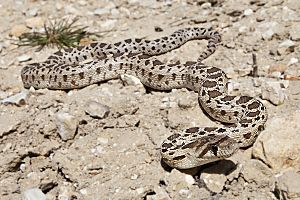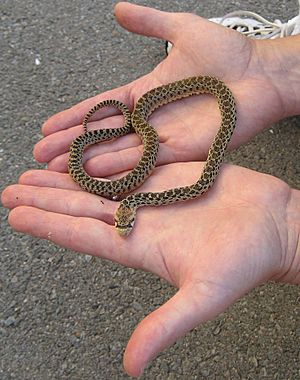Pacific gopher snake facts for kids
Quick facts for kids Pacific gopher snake |
|
|---|---|
 |
|
| Scientific classification |
|
| Kingdom: | Animalia |
| Phylum: | Chordata |
| Class: | Reptilia |
| Order: | Squamata |
| Suborder: | Serpentes |
| Family: | Colubridae |
| Genus: | Pituophis |
| Species: | |
| Subspecies: |
P. c. catenifer
|
| Trinomial name | |
| Pituophis catenifer catenifer (Blainville, 1835)
|
|
| Synonyms | |
The Pacific gopher snake (Pituophis catenifer catenifer) is a large, non-venomous snake. It lives along the western coast of North America. This snake is a subspecies of the gopher snake family.
Contents
About the Pacific Gopher Snake
Adult Pacific gopher snakes usually grow to be 4 to 5 feet (122–152 cm) long. Some can even reach 7 feet (213 cm)! Baby snakes, called hatchlings, are quite long when they are born. They can be over 20 inches (51 cm) long.
The main color of this snake can be yellow or dark brown. Its sides are often gray. It has dark brown spots all over its body. There are usually 41 to 99 spots on its body and 14 to 33 spots on its tail. The sides of the snake have 2 or 3 rows of black and brown spots that switch back and forth.
This snake has keeled scales, which means they have a ridge down the middle. Its head is narrow but wider than its neck. It also has a special scale on the tip of its snout that sticks out. While straw and straw gray are common colors, the snake's colors can vary a lot. The large spots on its back are usually dark brown or chocolate brown. Some snakes might even have black spots. The spots on its sides are often brown or gray. The back of its neck is dark brown. In some places, like Solano County, California, you might find striped versions of this snake.
The underside of the snake is usually cream-colored or yellowish with dark spots. Near the tail, especially on the back, you might see a reddish color. These snakes can be found in bushes and grassy areas, like gardens and yards.
How to Identify This Snake
The Pacific gopher snake has 2 to 3 rows of spots on its sides. This is different from the San Diego gopher snake (P. c. annectens), which has 3 to 4 rows of smaller spots. The large spots on the back of the Pacific gopher snake are solid. They do not have the empty look that San Diego gopher snake spots do. Also, the spots in the second row on the Pacific gopher snake are much bigger. Generally, the Pacific gopher snake has more large back spots than the San Diego gopher snake.
Behavior and Diet
Pacific gopher snakes are usually active during the day, which means they are diurnal. However, they might also be active at dusk or at night during warm weather. They like dry habitats such as meadows, fields, and farmland. You won't often find them in thick forests.
When a gopher snake feels scared or bothered, it can make a loud hiss. If it feels threatened, it will puff up its body and flatten its head. It will also shake its tail very fast. If its tail hits dry leaves or grass, it can sound like a rattle. But remember, gopher snakes are not venomous. They are usually calm and not harmful to people.
The Pacific gopher snake is a carnivore, meaning it eats meat. Its diet includes small mammals, especially pocket gophers. They also eat birds and their eggs, and sometimes lizards, insects, and even bats.
Life Expectancy
In the wild, Pacific gopher snakes usually live for 12 to 15 years. The oldest known gopher snake lived for over 33 years while in human care.
Reproduction
Pacific gopher snakes lay eggs, which means they are an oviparous species. The eggs are laid between June and August. They hatch in about 2 to 2.5 months.
When these snakes are bred by humans, they often go through a winter resting period. This period is called brumation. It helps them have more success with breeding. A group of eggs, called a clutch, usually has 12 to 14 eggs. These eggs hatch in about the same amount of time as in the wild.
Where They Live
The Pacific gopher snake lives along the West Coast of the United States. Their range goes all the way down to the southern coast of California. You won't often see gopher snakes above 2000 feet (610 meters) in elevation. They are most commonly found near farms in dry, brushy areas. You can also find the Pacific gopher snake in southern British Columbia and Alberta in Canada, and in Mexico.
Related pages
- Gopher Snake, a species of nonvenomous colubrid snake endemic to North America.
Gallery



